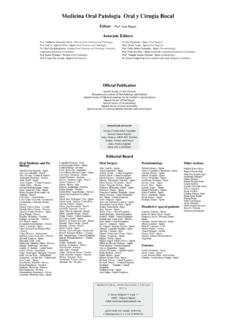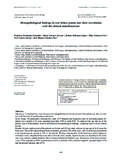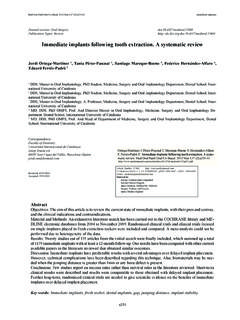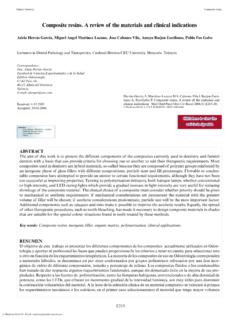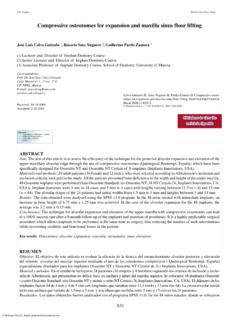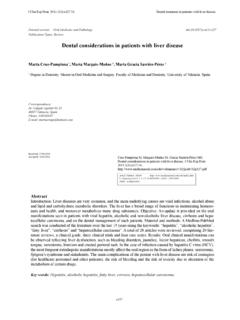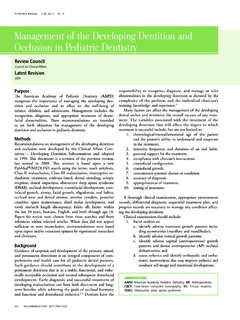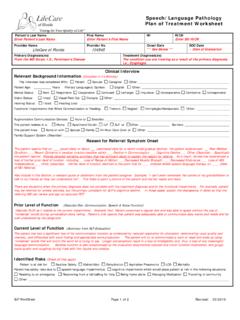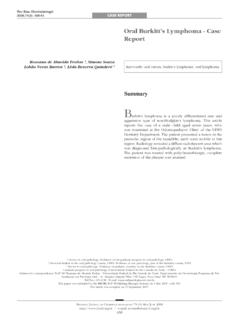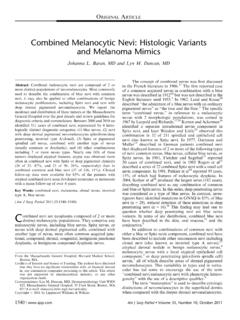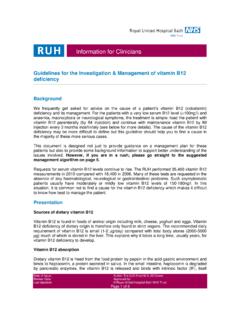Transcription of Antibiotic prophylaxis in Oral and Maxillofacial Surgery
1 E292 Neck and Facial pathology prophylaxis Surgery Med oral Patol oral Cir Bucal 2006;11:E292-6. prophylaxis Surgery Medicina oral Email: and Facial pathology prophylaxis Surgery Med oral Patol oral Cir Bucal 2006;11:E292-6. prophylaxis SurgeryAntibiotic prophylaxis in oral and Maxillofacial SurgeryJose Ignacio Salmer n Escobar 1, Alvaro del Amo Fern ndez de Velasco 2 (1) M dico Adjunto (2) M dico Residente.
2 Gregorio Mara n de MadridCorrespondence:Dr. Jose Ignacio Salmer nC/Rodr guez Mar n 7128016 MadridE-mail: 17-12-2005 Accepted: 5-04-2006 Salmer n-Escobar JI, del Amo-Fern ndez de Velasco A. Antibiotic prophylaxis in oral and Maxillofacial Surgery . Med oral Patol oral Cir Bucal 2006;11:E292-6. Medicina oral S. L. B 96689336 - ISSN 1698-6946 ABSTRACTA ntibiotic prophylaxis in oral and Maxillofacial Surgery aims the prevention of the infection of the surgical wound, either due to the characteristics of the Surgery or the general state of the patient. This risk increases with the contami-nation of the surgical operation area, making it necessary to imply a prophylactic treatment of the infection in clean-contaminated and contaminated surgeries and treatment of the infection in dirty surgeries.
3 Moreover, a proper surgical technique helps to reduce the development of the postsurgical infection. The elective Antibiotic chemotherapy ranges from penicillin-derivates with betalactamase inhibitors (amoxycillin-clavulanate, ampicilin-sulbactam) to second or third generation cephalosporins, quinolones or clindamycin. The indication for the use of these antibiotics depends on the type of Surgery in oral and Maxillofacial Surgery , according to the degree of contamination. Thus in oral Surgery and Surgery of the salivary glands the literature demonstrates that there is not a better prognosis when using prophylactic antibiotherapy instead of not using it in healthy patients.
4 In traumatology this prophylaxis is justified in compound fractures and those communicating with paranasal sinuses. In orthognatic Surgery there is disagreement according to the criteria of using Antibiotic prophylaxis , but short term treatment is preferred in case of using it. In oncological Surgery it has been demonstrated the reduce in incidence of postsurgical infection using prophylactic peroperative antibiotherapy, mostly in those cases in which oral mucosa and cervical area words: Infection, oral cavity, Antibiotic , Maxillofacial Surgery , profilaxis antibi tica en cirug a oral y maxilofacial tiene como fin la prevenci n de la infecci n en la herida quir rgica, ya sea por las caracter sticas de la cirug a o por el estado general del paciente.
5 Este riesgo se incrementa cuanto m s se contamine el campo quir rgico, siendo necesario realizar tratamiento profil ctico de la infecci n en cirug as limpias-contaminadas y contaminadas y tratamiento de la infecci n en cirug as sucias. Adem s, una adecuada t cnica quir rgica colabora con la reducci n de la aparici n de infecci n postquir rgica. La antibioterapia de elecci n var a entre derivados de la penicilina con inhibidores de las betalactamasas (amoxicilina-clavul nico, ampicilina-sulbactam), cefalosporinas de segunda o tercera generaci n, quinolonas o clindamicina. La indicaci n de su uso variar en funci n del tipo de cirug a en cada mbito de la cirug a oral y maxilofacial, seg n el grado de contaminaci n de la misma.
6 De este modo en cirug a oral y en patolog a de gl ndulas salivares la literatura parece demostrar que no hay mejor pron stico en cuanto al uso de antibioterapia profil ctica respecto a no usarla en pacientes sanos. En traumatolog a se justifica en fracturas compuestas o con comunicaci n con senos paranasales. En cirug a ortogn tica hay discrepancia en cuanto al criterio de empleo de profilaxis antibi tica, si bien se prefieren ciclos cortos de tratamiento. En cuanto a la cirug a oncol gica, Indexed in: -Index Medicus / MEDLINE / PubMed -EMBASE, Excerpta Medica-Indice M dico Espa ol -IBECSC lick here to view the article in SpanishNeck and Facial pathology prophylaxis Surgery Med oral Patol oral Cir Bucal 2006;11:E292-6.
7 prophylaxis SurgeryE293 Neck and Facial pathology prophylaxis Surgery Med oral Patol oral Cir Bucal 2006;11:E292-6. prophylaxis SurgeryINTRODUCTIONThe aim in surgical Antibiotic prophylaxis is to prevent the possibility of an infection in the surgical wound, creating an area of resistance to microorganisms by means of Antibiotic serum concentrations that may avoid the multiplication and spread of bacteria through the surgical injury.
8 The prophylaxis is always indicated when there is an impor-tant risk of infection, because of either the features of the operation or the local or general conditions of the patient. Among the factors that could be the cause for this infec-tion, the ones that should be emphasized are the type and duration of the Surgery and the surgical risk of the patient (ASA risk) due to his comorbidity: diabetes, nephropathies, hepatopathies (cirrhosis), cardiopathies, inmmunosupres-sors (corticoids, radiotherapy, chemotherapy, previous infections undertreated or mistreated with other antibiot-ics). Minor surgical procedures in healthy patients may not require the surgical injury comes about with in the skin wound, the main physical barrier that stops the entrance of microorganisms into the body breaks down (1).
9 Because of this event, these microorganisms penetrate and may colonize and cause infection of deep tissues (2). According to the amount of bacteria, the possibility of infection elevates, also depending on whether it is a clean, clean-contaminated, contaminated or dirty Surgery . The more contamination in the wound, the more risk of postsurgical infection. The risk of contamination of the surgical area reduces with an appropriate surgical technique, a good health of the patient, etc (3), (4), but the one that has been considered the most important factor is Antibiotic prophylaxis . Anti-biotics in Surgery must be used just in those cases in which is indicated and the pharmacocynetics of the drug should be appropriate as well as the spectrum of of control of the infection in the surgical tech-nique in order to reduce the risk of infection are clean in-cissions, mucoperiosteal flaps avoiding tearing the mucosa, constant irrigation to cool the surgical area and clean the debris, constant aspiration, careful haemostasis, avoid in-juries with the needle of the local anesthesia, slow entrance of the anesthetic agent.
10 Drainages and surgical dressings when It must be underlined the importance of the entrance in the postoperative period of liquids and remains of food through the surgical wound, therefore it should be recommended to make mouthwashes after 24 hour postoperative time onwards. A good prophylaxis happens when there are effective serum concentrations of the drug since the opening of the skin of mucosa until its closure. Due to this fact, the Antibiotic should be used in the hour previous to the incision. The best moment is during the anaesthetic induction via intravenous. In case of long-lasting Surgery , it could be necessary to re-peat the Antibiotic dose to keep therapeutic serum levels of the drug, according to the pharmacocynetics of each anti-biotic.
